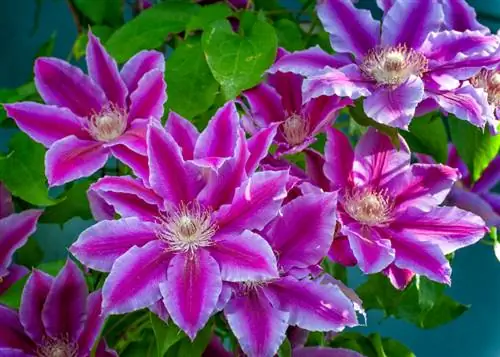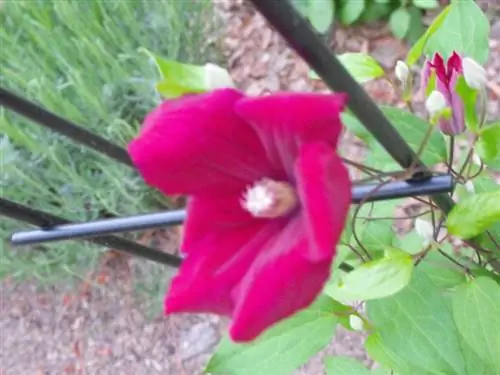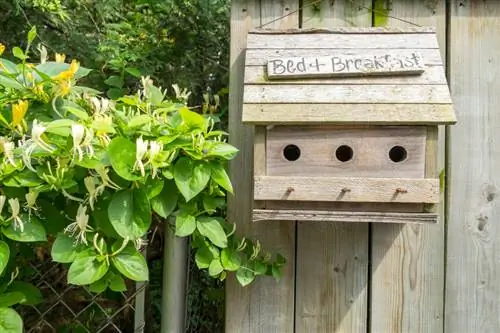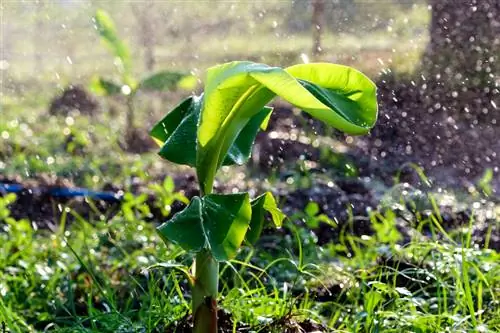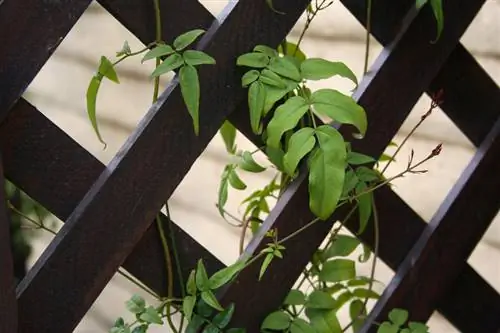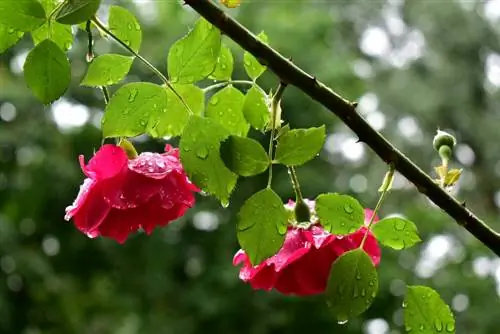- Author admin [email protected].
- Public 2023-12-16 16:46.
- Last modified 2025-01-23 11:20.
For the clematis to live up to its reputation as a prime example of a glamorous climbing plant, professional care is important. Here, hobby gardeners receive the tools they need to perfectly cultivate clematis. Find answers to all fundamental questions.

How do I care for my clematis successfully?
A clematis needs slightly moist soil, sufficient nutrient supply through fertilization, regular pruning depending on the variety and flowering time, protection against diseases such as clematis wilt and mildew and, if necessary, winter protection. Pest infestations can be avoided by strengthening plants and designing gardens close to nature.
How to water the clematis?
A clematis develops its most beautiful flowers in constantly slightly moist soil. This requirement must be taken into account in the garden as well as in the pot. Therefore, check the surface of the earth regularly with your thumb. If the substrate feels dry, water directly to the root area.
In what dosage should the clematis be fertilized?
Only a sufficient supply of nutrients provides the majestic clematis with enough energy to produce the huge mass of leaves and the dense floral bloom. Therefore, fertilize the clematis like this:
- With mineral-organic special fertilizer in March/April and June/July at a dosage of 100 grams per square meter
- Fertilize clematis in the pot every 4 weeks from March to September with 20 grams of fertilizer granules
- After each fertilization in the garden and planter, water generously
Alternatively, fertilize with compost and horn shavings every 8 to 14 days from March to September. Alternatively, administer potassium-rich comfrey manure, optionally mixed with nettle manure.
What is important when pruning?
If you care for Clematis properly, regular pruning plays an essential role. The different species and varieties must not be lumped together. For better orientation, a distinction is made into 3 cutting groups, based on the respective flowering period. How to do it right:
- Early flowering clematis (pruning group 1) cut by a third or half after flowering in May/June
- Summer flowering clematis (pruning group 2) in late summer - August/September - shorten by at least 30 percent
- Short autumn bloomers heavily in November/December or February/March for compact growth
- Fruits generally immediately due to the high energy consumption
After planting, every young clematis receives a planting cutting in the first spring. To do this, cut the young plant back to 30 or 50 centimeters so that it branches lushly and develops a bushy habit. Wild species of clematis that bloom in spring on the previous year's shoots should only be cut when flowering has waned.
Which diseases threaten the clematis?
The sword of Damocles of the clematis wilt dangles above the large-flowered clematis. This is a fungal infection that can be recognized in the first stage by brown spots with a yellow atrium. As the process progresses, the entire leaf turns brown and falls off. The shoots are not spared either. How to react correctly:
- Remove infected leaves immediately at the first sign
- Do not dispose of in the compost but in household waste
- Treat the infected clematis with a fungicide (€11.00 on Amazon) against fungal infections
- If the shoots are infected, cut the entire plant back close to the ground
Even if you care for the clematis properly, mildew does not spare the climbing plant. If there is a mealy-white coating on the foliage, treat the infection with Naturen Bio-Netzulfur or Atempo Kupfer-Fungzfrei. In the biological control of mildew, repeated spraying with a mix of 100 milliliters of fresh milk with 1 liter of water has proven successful.
Which pests stalk the clematis?
If a clematis is attacked by pests, plagued hobby gardeners usually have to deal with the following beasts:
- woodlice when they appear en masse in the garden
- Aphids, the omnipresent pests do not spare the clematis
- Black weevils nibble on leaves, flowers and roots at night
- Earwigs attack the stamens
- Thrips suck the sap out of clematis
If you care for your clematis properly, you will also strengthen its resistance to pests. In addition, many natural predators of these pests, such as toads, birds, parasitic wasps, hedgehogs and other beneficial insects, settle in a natural garden. Therefore, create retreats such as hedges, piles of leaves, dry stone walls and hollow tree trunks.
Is winter protection necessary?
Planted in the garden, most Clematis species and varieties prove to be hardy. Light winter protection is only recommended in the first year. This is what it should be like:
- Pile a thick layer of leaves or straw over the young plants
- Alternatively cover with jute or garden fleece
If the winter is frosty but without snow, the clematis is threatened by drought stress. When there is a frost, prudent hobby gardeners water the clematis on frost-free days.
Keep from frost in the pot every year
In view of the exposed position of the root ball in the planter, we recommend winter protection for the clematis every year. Place the bucket on an insulating wooden base and cover the container with bubble wrap.
Tips & Tricks
Some of the early-blooming clematis can be persuaded to bloom again in the summer. Clean the clematis thoroughly after the first flowers and in particular remove all fruit stalks. Instead of growing seeds, the climbing plant invests its energy in another flower bloom after 6 to 8 weeks.

